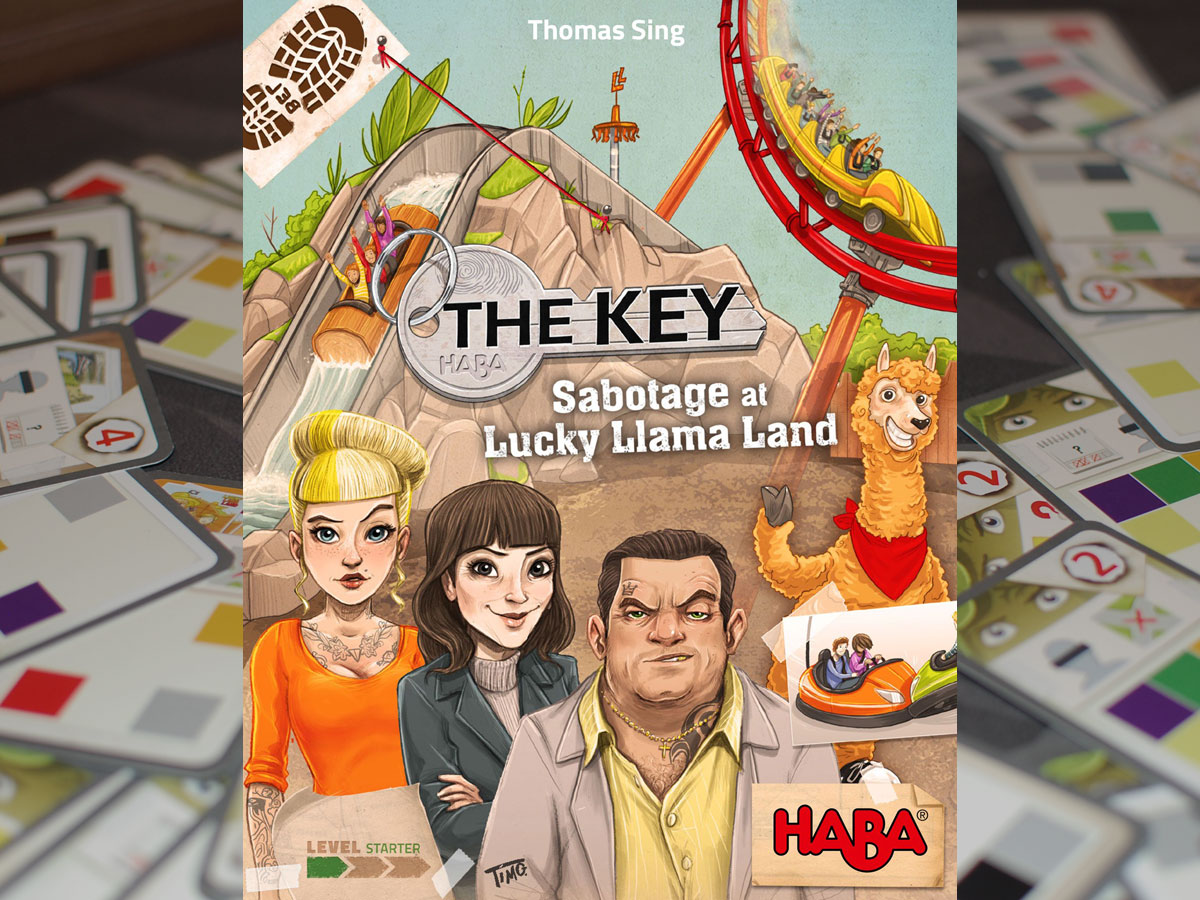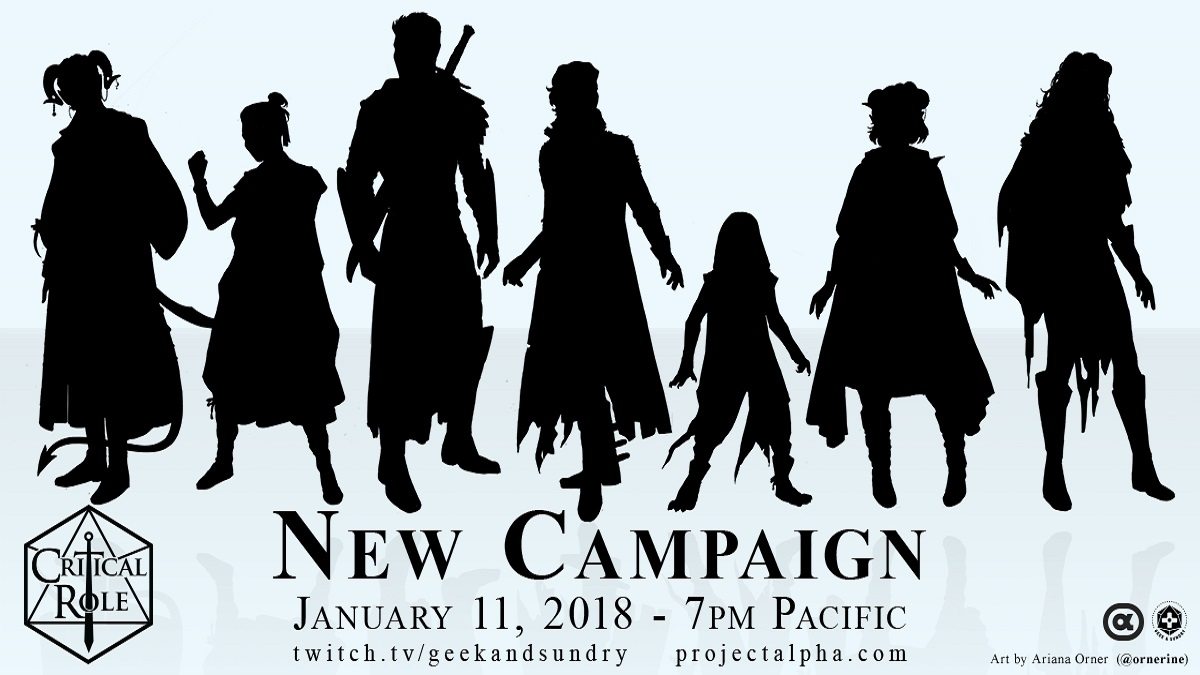Three suspects have been apprehended sabotaging rides at a theme park. Can you piece together the timeline of who did what?
What Is The Key: Sabotage at Lucky Llama Land?
The Key: Sabotage at Lucky Llama Land is a logic and deduction game for 1 to 4 players, ages 8 and up, and takes about 20 minutes to play. It retails for $34.99 and is available to order directly from HABA. The deduction may be a little tricky for younger players so they may need some assistance; the theme is about three suspects sabotaging rides at a theme park, but nobody gets hurt so there’s nothing too scary for kids. Although the box says 20 minutes, the game can take longer if players want to spend more time working on the case.
The Key: Sabotage at Lucky Llama Land was designed by Thomas Sing and published by HABA, with illustrations by Timo Grubing.
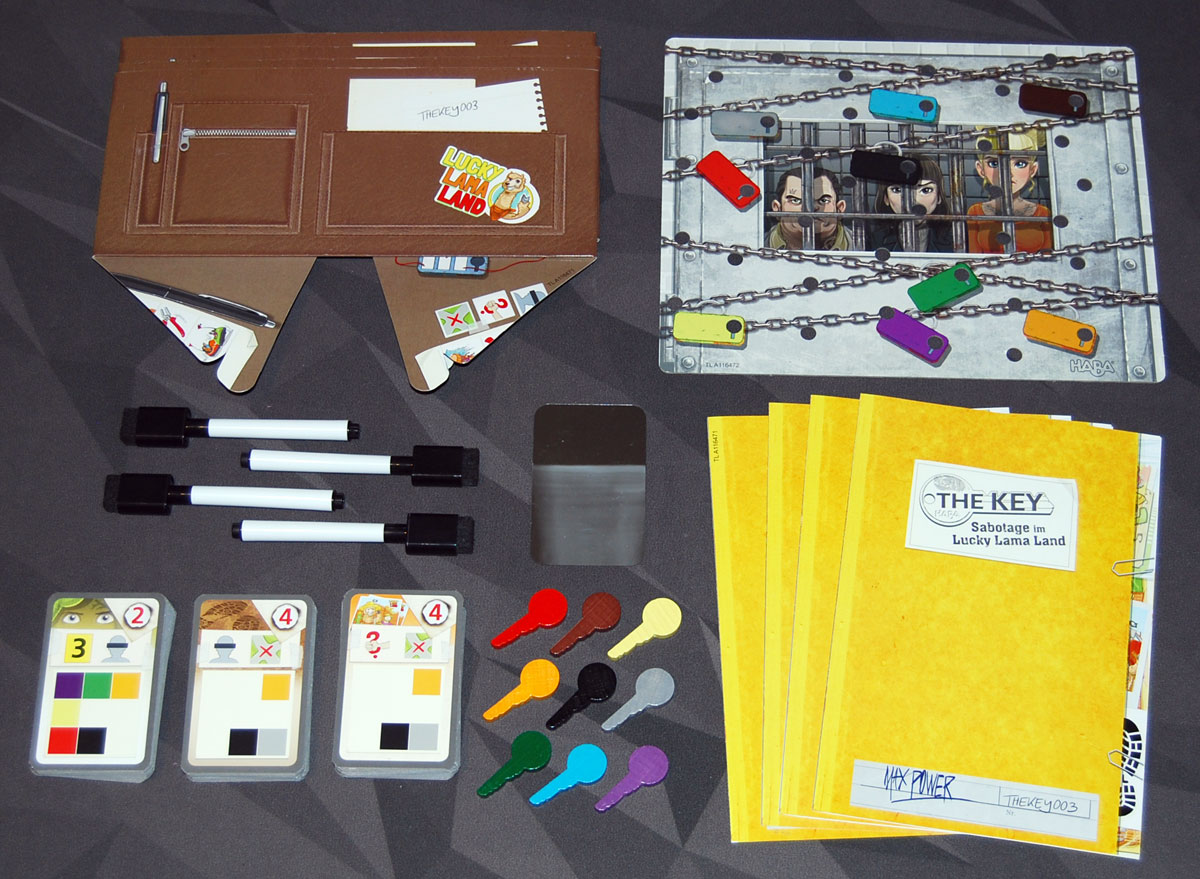
The Key: Sabotage at Lucky Llama Land Components
All the components in The Key: Lucky Llama Land are in both English and French.
Here’s what comes in the game:
- 4 Briefcase screens
- 4 Investigation files
- 1 Solution board
- 4 Dry-erase markers
- 9 Keys
- 1 Mirror card
- 140 Clue cards
- 86 Witness Statement cards
- 18 Shoeprint cards
- 18 Show Ticket cards
- 18 Snapshot cards
The screens fold to form a three-sided screen with a flat base where you work out your solution: one of the side panels has a chart for creating the “code” for your solution, and the other side and front panel have illustrations that are mostly for flavor (though the mug shots do provide some information for interpreting clues).
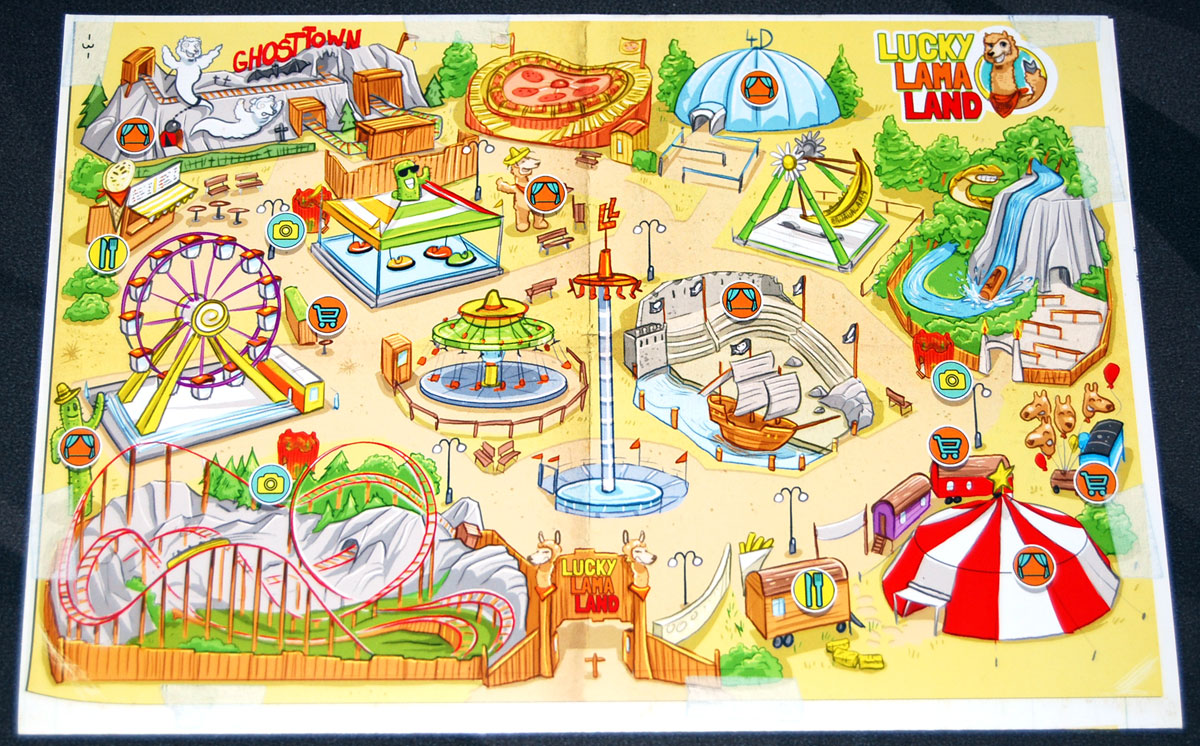
The investigation file is a single folded sheet that contains a lot of information you’ll need for understanding the clues: dossiers on each suspect with name, age, and shoeprint; the length and weight of the three tools used for sabotage; a chart showing which rides were open for a particular week; and a park map of Lucky Llama Land with points of interest marked. The park map in particular is nicely done and looks like something you’d get from a theme park—you actually only need a couple of the icons on it for the game, and the rest are just there for flavor. Although the information is identical in the files, they do have different detective names on the cover, just as a fun extra detail.
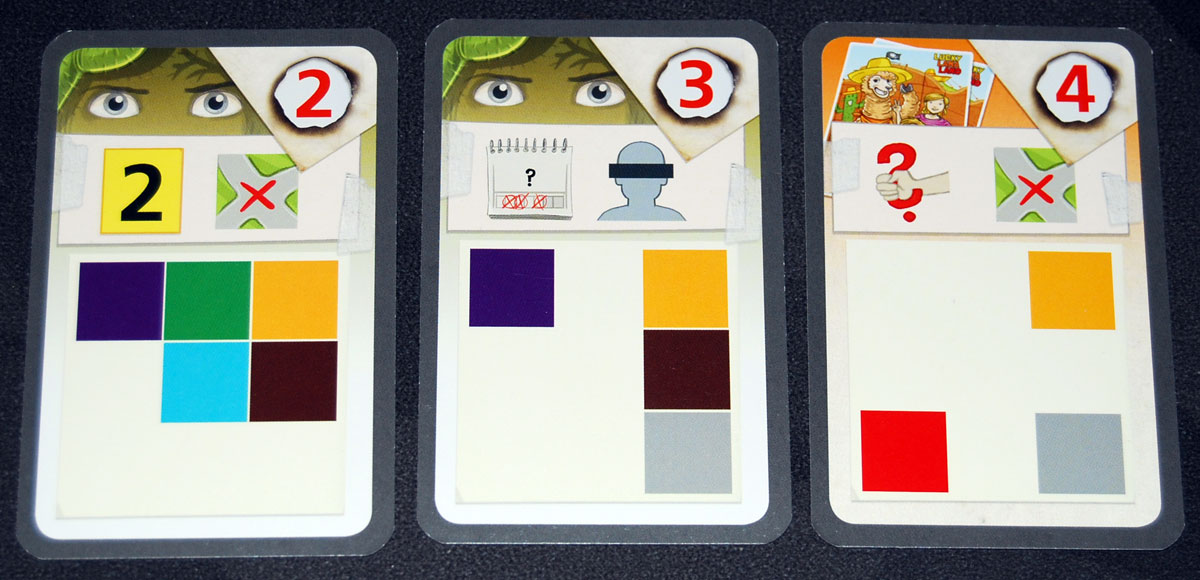
The clue cards have some icons on the back indicating the type of clue it is (witness statement or one of the various lab results), so that you can gauge what type of information you’ll glean from the clue. There’s also a large red number in the corner—that’s how many “investigative points” the card is worth, because you’ll be competing to solve the crimes using the fewest points. The bottom half of the card has a 3×3 grid showing some portion of the 9 different colors corresponding to the keys. It’s important, but I’ll explain that more later. The front of the card has the actual clue, and each of the clue types presents information in a different way.
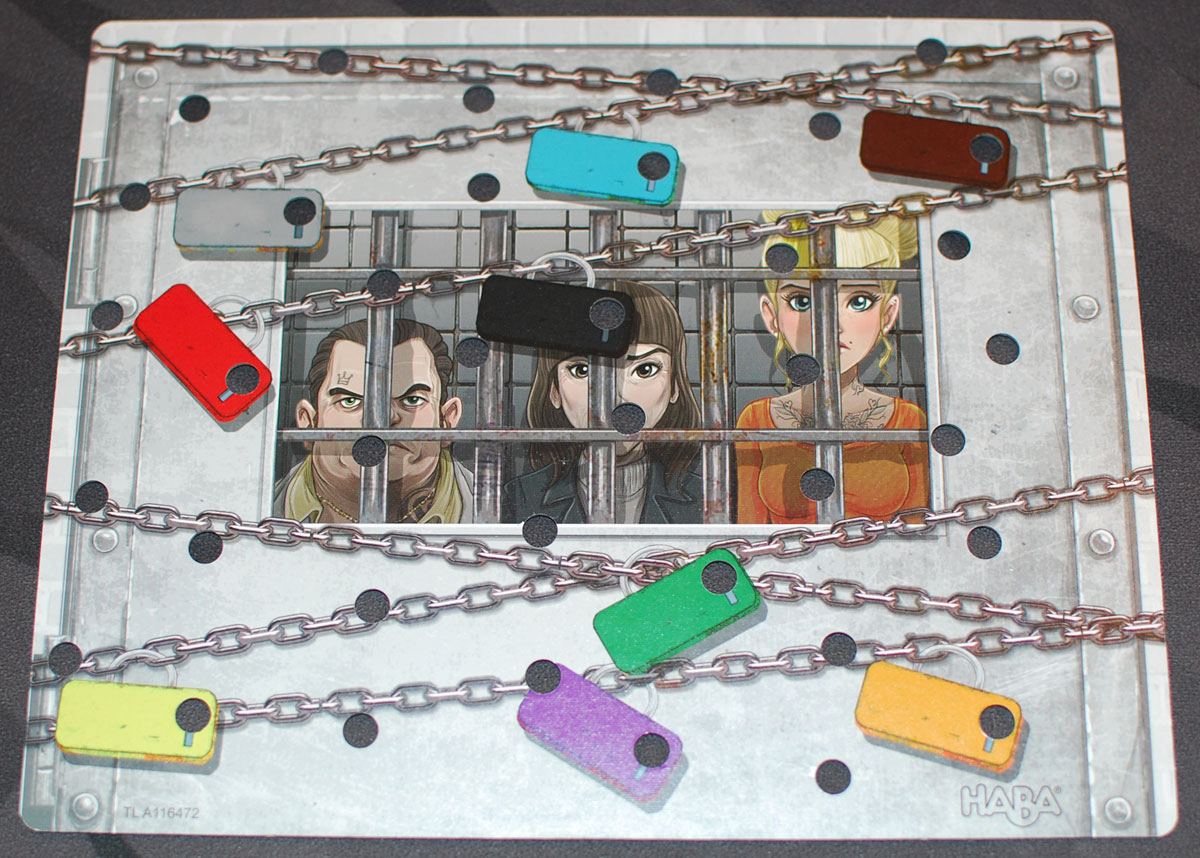
The solution board (combined with that color grid) is what allows you to play the game multiple times, and it’s a clever design. It’s just a large board with lots of holes all over it, including 9 that are keyholes to colored locks. On the back, each hole shows a lock with a three-digit combination. The keyhole for each color matches up with the combination that represents its solution—all the other locks are red herrings so you don’t accidentally see the solution.
Overall, the component quality is good, though storage (as with most HABA titles) is simply a plain box with no insert, so you’ll just keep the cards and keys in baggies and stack the rest of the flat components.
How to Play The Key: Sabotage at Lucky Llama Land
You can download a copy of the rulebook here.
(Note: images shown in this review are not spoilers, because I’ve used cards from different cases so they don’t necessarily point to one solution.)
The Goal
Here’s the story: three suspects sabotaged three rides at Lucky Llama Land on three different days, using three tools. You need to match up the information to know who did what and when.
The goal of the game is to solve the case correctly using the fewest investigative points. The person who finishes first will get a bonus toward investigative points, but you can only win if you have the correct solution. (If playing solo, simply try to solve the mystery with the fewest points possible, and check your score against the table.)
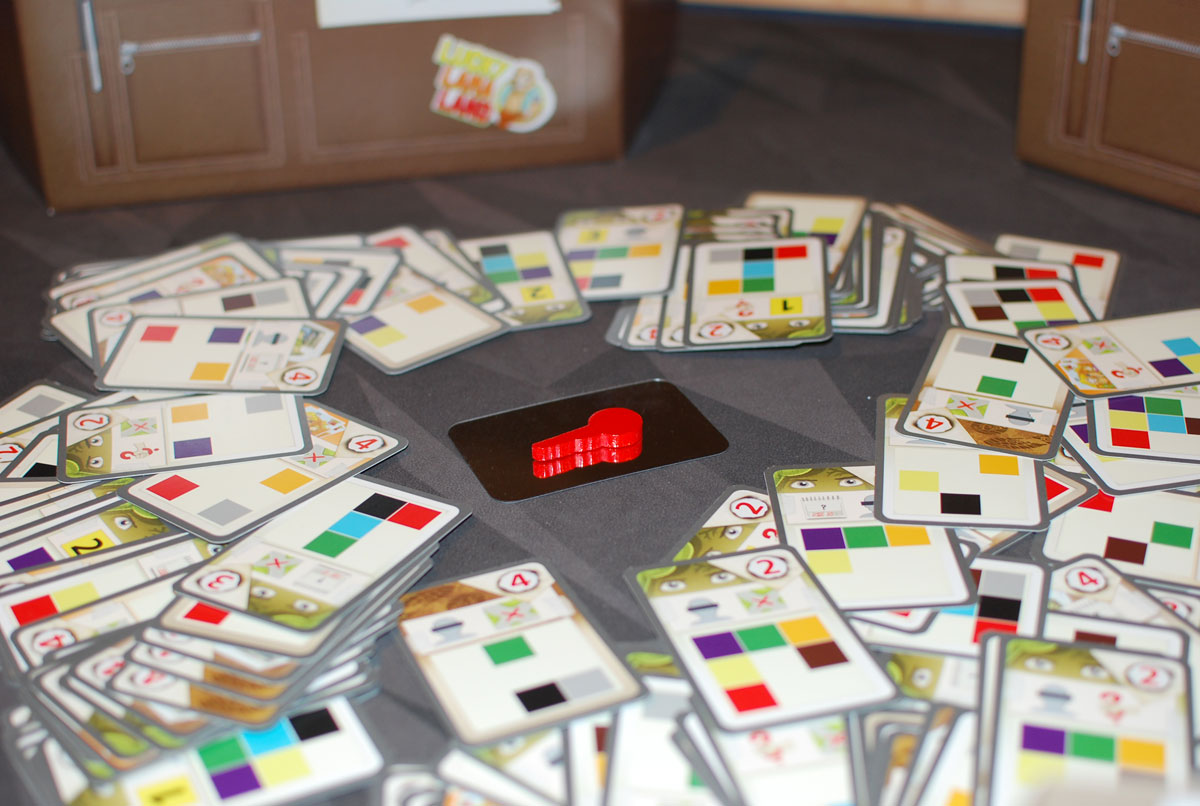
Setup
Setup is a snap! Give each player a briefcase shield, a marker, and an investigation file. Pick a key and place it and the mirror card in the center of the table. Then, take all of the clue cards and spread them around the table in a big mess.
Gameplay
There is no turn order: everyone plays simultaneously at their own pace. You take clue cards from the table, mark whatever observations you can deduce from them, and then add the cards to your own scoring stack.
The color of the key determines which of the 9 solutions you’re trying to figure out: clue cards that have the matching color on the back will provide accurate information, and all other cards will be red herrings, so pay attention to what you grab!
On the back of the card, the top banner indicates what type of clue it is, and the icons below that tell you whether the card will provide info about the suspect, the date, the tool, the location, or a particular day (1, 2, or 3). The more investigative points a card has, the more conclusive the clue will be.
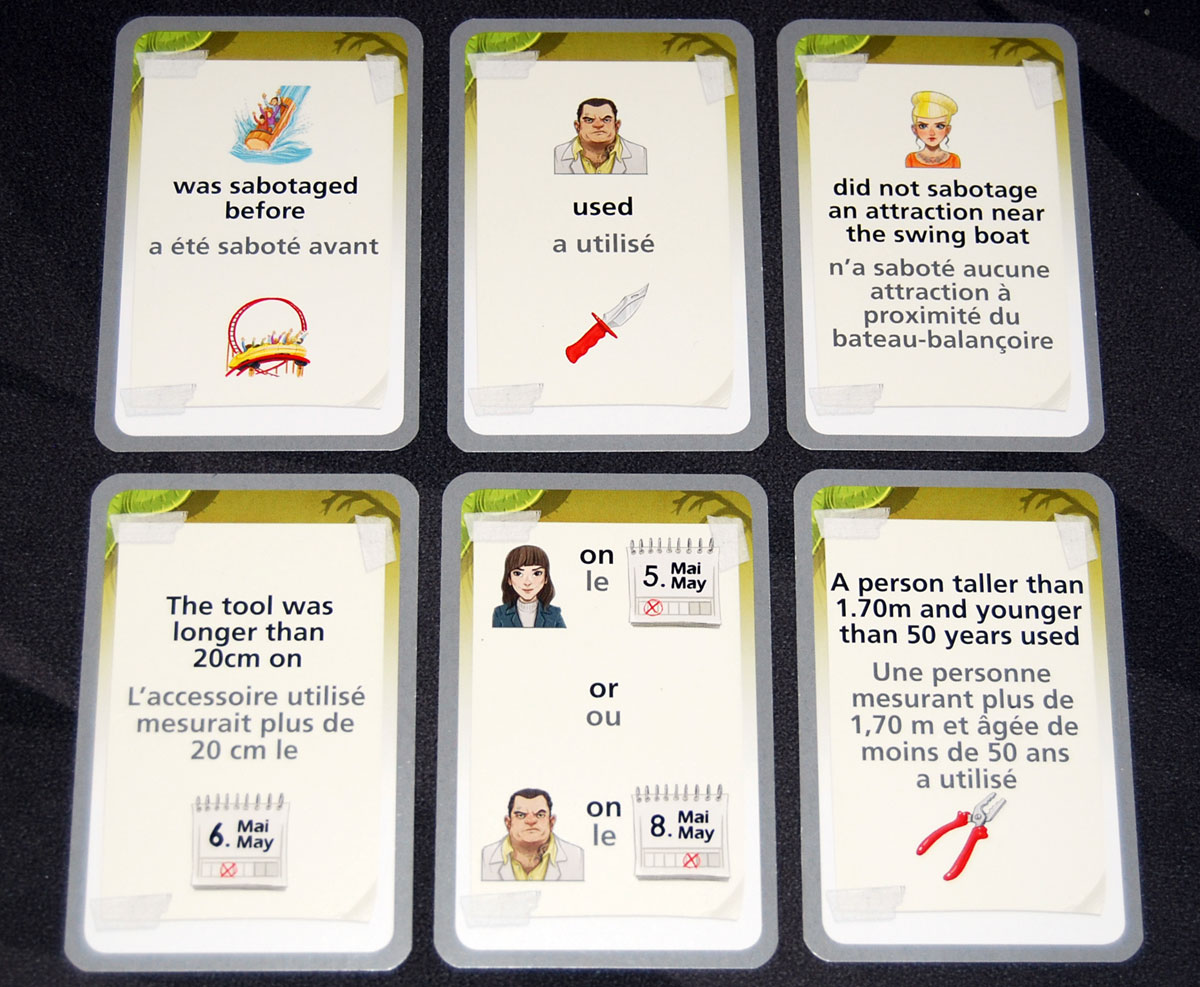
Witness statements come in a variety of forms: you may find out that Olivia didn’t use the pliers, or that the roller coaster wasn’t sabotaged on Tuesday. You might get a small illustration of a location from the map, and be told something about a ride that you can see from that location.
The other types of cards are “lab” cards, and provide some sort of evidence, and each one has its own method of deciphering.
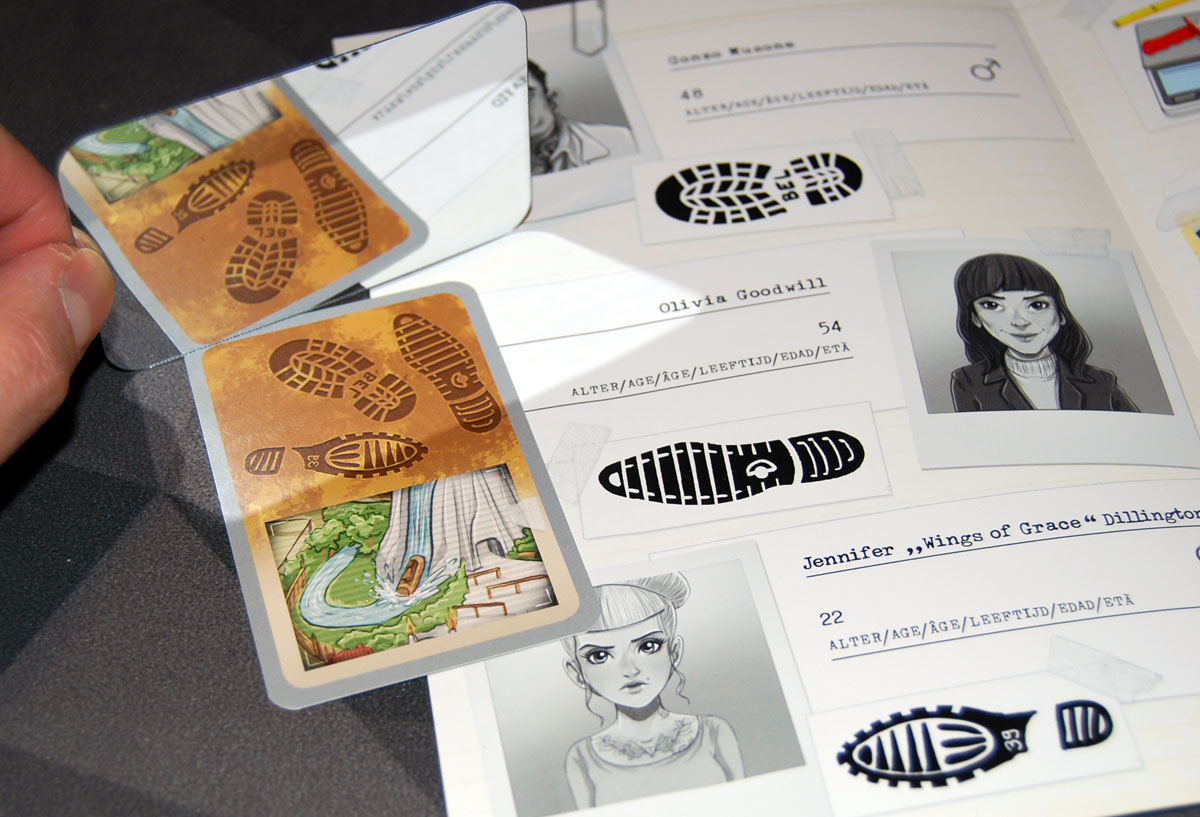
Shoeprint cards will show three prints paired with one of the rides, and help you tie a suspect to a location. However, the shoeprints are mirror images from the ones found in your investigation file, so that’s where the mirror comes in. One will be an exact match and the other two will differ (usually in very tiny ways)—the one that is an exact match is your suspect!
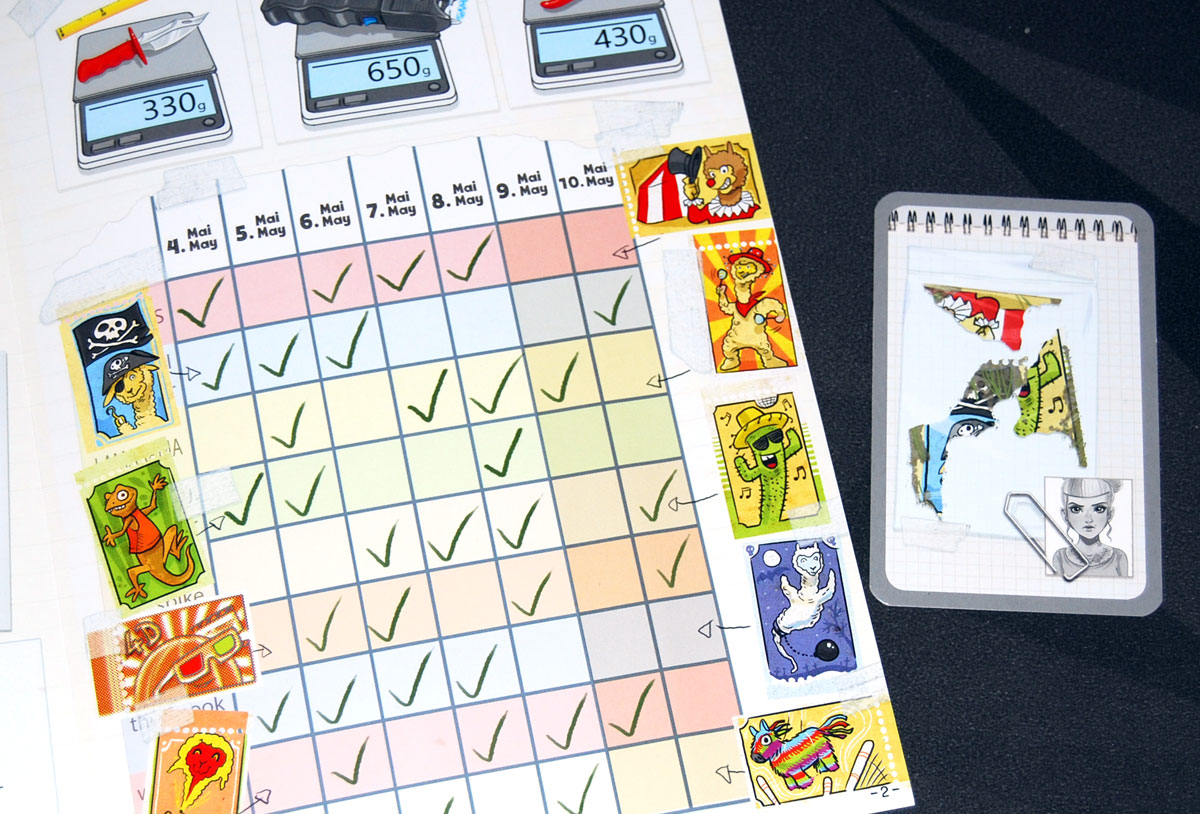
Show ticket cards show you a few ticket stub scraps taken from one of the suspects, and help you tie a suspect to a date. You’ll have to compare the partial tickets to the ride calendar in your file: if any of the matching rides was closed on a particular date, then you can eliminate that date for that suspect.

Snapshots help connect a crime scene to a particular tool. It turns out the suspects dressed up as the Lucky Llama mascot to get around, and sometimes posed in photos with parkgoers at one of the three photo spots (which happen to be near the three sabotaged rides). You’ll have to compare the photo with the park map to see which location the photo was taken from, and then you know which ride that particular tool was used on.
When you think you’ve reached a solution—that is, you know which suspect used which tool on which ride for each of the three days—then you’ve closed the case. Circle the suspect, tool, and ride for each day on your briefcase screen. If you’re the first to do so, grab the key from the center of the table. You aren’t allowed to change anything once you’ve grabbed the key. Other players may continue taking cards and working on the case.

Generate a 3-digit code by consulting the chart on your screen and the order things happened. For instance, if you think the rides were sabotaged in the order roller coaster, bumper cars, whitewater ride, then that would be “1” according to the chart. Write your three-digit code in the lock at the bottom.
Game End
Once everyone has closed the case (or given up), then you check your solutions. The player with the key inserts it into the matching lock on the solution board, and then flips it over to see the solution code. If your code matches, you’ve solved the case! Otherwise, you made a mistake somewhere.
Any players who solved the case then add up their total investigative points. The player who grabbed the key (if they were correct) may discard one of their cards of the lowest value. The player with the lowest score wins, with ties going to the player with the fewest lab cards.
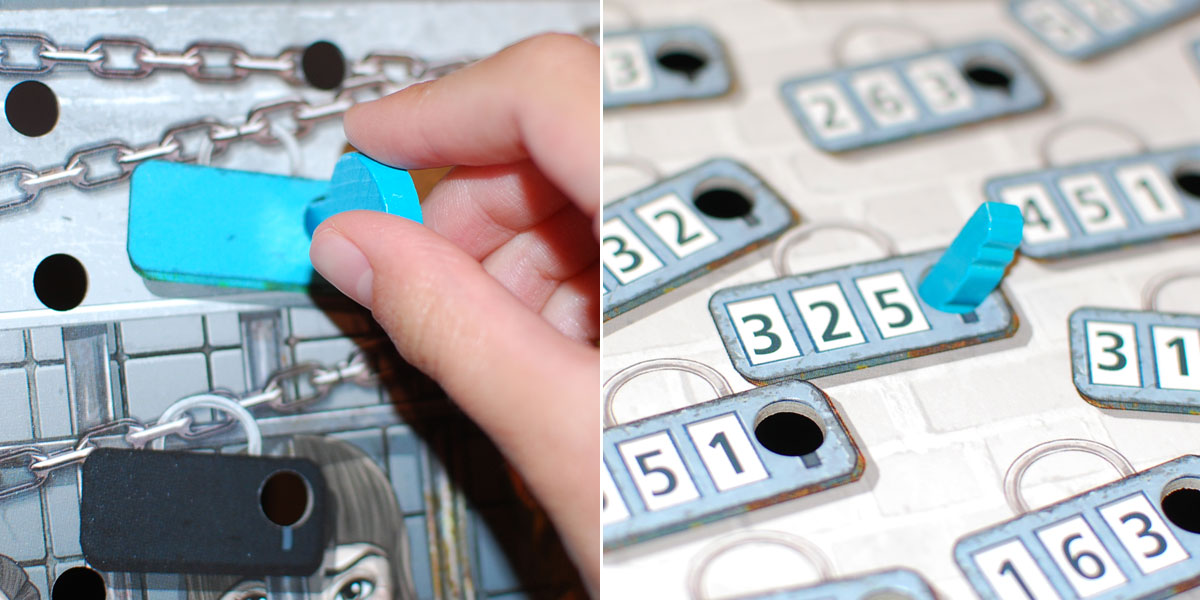
Why You Should Play The Key: Sabotage at Lucky Llama Land
I love deduction games and logic puzzles, and The Key really scratches that itch. You know those grid puzzles where Bob has a green house, and the person in the yellow house lives next door to a lawyer, and the dog’s owner doesn’t work at the grocery store… well, The Key reminds me a little bit of those puzzles, except that instead of a list of clues you’re digging through a pile of cards for them—and some clues may help you more than others.
Story-wise, it’s a little silly. Somehow you know that three different rides were sabotaged on three different days… but you don’t know which ride was sabotaged on which day? I mean, I get that you’re trying to figure out who sabotaged each ride and how they did it… but it does seem like it’d be pretty easy to know which ride stopped working on Tuesday and which ride stopped working on Wednesday.
That aside, though, it’s a very fun puzzle to solve. I like the way the different types of clues are resolved and the way that you can get different types of information. For instance, if you’ve tied a person to a ride but you don’t know which day it was, then you might look for a clue that ties a ride to a particular date, and then that pins down all of the information. Some clues give you an either/or, so you have to connect it to another clue to know which statement is true.
The witness statements refer to all sorts of information: the height of a suspect, the color of a tool’s handle, whether some days were consecutive or not. As you go, you can use your briefcase screen to scribble down notes and cross out things you’ve eliminated. The other thing you’ll find, though, is that there is a lot of redundant information. For any given key color, there are a whole lot of cards (enough, presumably, for four different players each to draw enough cards to solve the mystery)—which means that sometimes you’ll get a wasted draw. That’s where it gets important to look at the back of the card first, because at least you can dig for cards that have the type of info that you’re still missing.
When playing against other players, you want to be quick—but in the end, it’s more important to be accurate than fast. Finishing fastest (which I often did) only gives you a bonus of a single card, and since you only get to discard one of your lowest value cards, chances are you’re only saving 2 investigative points by being first. Meanwhile, if you’re wrong, those two points don’t help you win the game. (Still, I admit that I like to race through as quickly as possible… which hasn’t always paid off.) The lab cards are all worth 4 points, but they tend to provide more information, so you need to balance how many you take of each card.
The different colors on the card backs is a very cool system. When I first saw that the box claims “countless investigation adventures,” I really wondered how they would pull that off: usually if you solve a mystery game, then you know the answer and you can’t play it again, right? But in this case, each of the key colors results in a different solution—and the incorrect cards serve as distractions—so you can play 9 times with different results. What’s more, after you’ve played a few times, it’s unlikely that you’ll remember which 3-digit code goes with which key color, so you’re not necessarily limited to 9 plays. (And even if you played the color again later, you’ll be drawing different cards, so you may take a very different path to the solution.) Since your solution is encoded into a 3-digit number, that puts the actual suspect names, ride names, and tool names at one more level of abstraction from the answer, which also helps in case you want to replay a color.
The solution board is also a brilliant way to check your answer: it’s so simple to insert the key and check if anyone got the right code. I also like that there are lots of extra holes and codes on the back of the board, so that it’s not immediately obvious which codes go with which colors when you flip the board over, keeping you from accidentally seeing a solution to a different color.
Lucky Llama Land is just one case in The Key series, and has a “starter” difficulty level. That said, I think it’s already engaging and provides a good puzzle to solve. For younger kids, you might want to treat it more like a solo game, where you just work together to choose clues and put them together. It would be a fun way to learn logic and deduction skills! So far I’ve only tried one other title, which I’ll share about in the future, but this one was an excellent introduction to the series.
If you like logic puzzles and deduction, I encourage you to take a look at The Key: Sabotage at Lucky Llama Land! Visit the HABA website for more information or to order a copy.
Click here to see all our tabletop game reviews.
![]() To subscribe to GeekDad’s tabletop gaming coverage, please copy this link and add it to your RSS reader.
To subscribe to GeekDad’s tabletop gaming coverage, please copy this link and add it to your RSS reader.
Disclosure: GeekDad received a copy of this game for review purposes.
